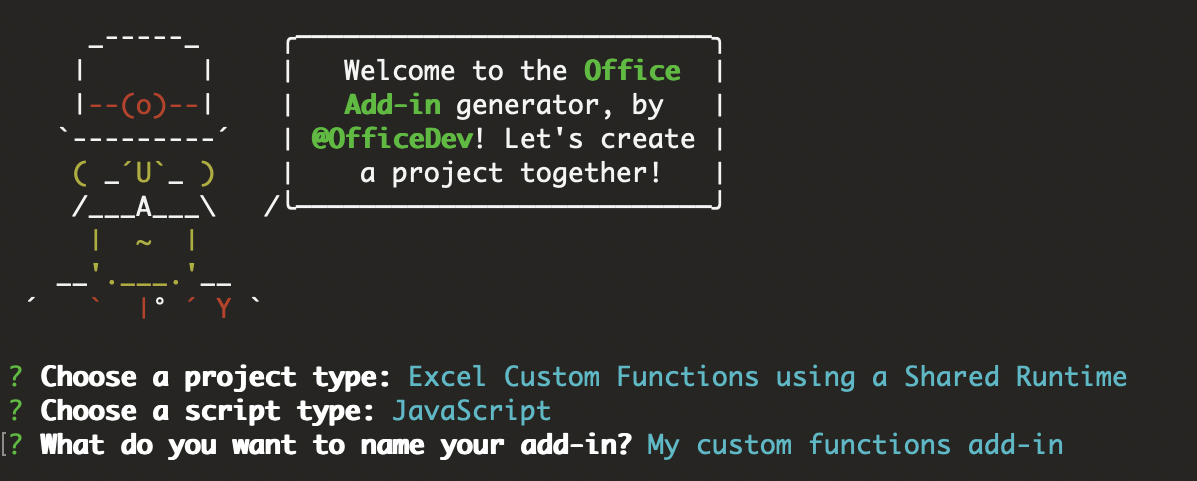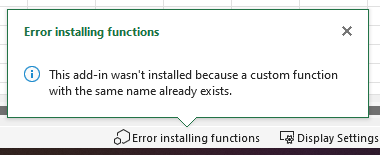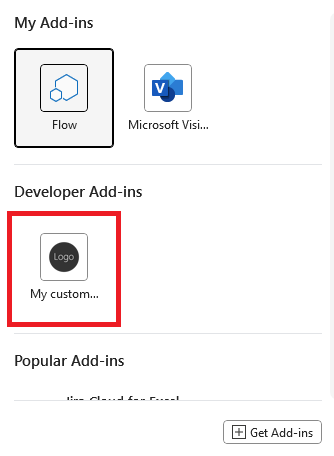Note
Access to this page requires authorization. You can try signing in or changing directories.
Access to this page requires authorization. You can try changing directories.
With custom functions, developers can add new functions to Excel by defining them in JavaScript or TypeScript as part of an add-in. Excel users can access custom functions just as they would any native function in Excel, such as SUM().
Prerequisites
Node.js (the latest LTS version). Visit the Node.js site to download and install the right version for your operating system.
The latest version of Yeoman and the Yeoman generator for Office Add-ins. To install these tools globally, run the following command via the command prompt.
npm install -g yo generator-officeNote
Even if you've previously installed the Yeoman generator, we recommend you update your package to the latest version from npm.
Office connected to a Microsoft 365 subscription (including Office on the web).
Note
If you don't already have Office, you might qualify for a Microsoft 365 E5 developer subscription through the Microsoft 365 Developer Program; for details, see the FAQ. Alternatively, you can sign up for a 1-month free trial or purchase a Microsoft 365 plan.
Build your first custom functions project
To start, you'll use the Yeoman generator to create the custom functions project. This will set up your project with the correct folder structure, source files, and dependencies to begin coding your custom functions.
Run the following command to create an add-in project using the Yeoman generator. A folder that contains the project will be added to the current directory.
yo officeNote
When you run the
yo officecommand, you may receive prompts about the data collection policies of Yeoman and the Office Add-in CLI tools. Use the information that's provided to respond to the prompts as you see fit.When prompted, provide the following information to create your add-in project.
- Choose a project type:
Excel Custom Functions using a Shared Runtime - Choose a script type:
JavaScript - What do you want to name your add-in?
My custom functions add-in

The Yeoman generator will create the project files and install supporting Node components.
- Choose a project type:
The Yeoman generator will give you some instructions in your command line about what to do with the project, but ignore them and continue to follow our instructions. Navigate to the root folder of the project.
cd "My custom functions add-in"Build the project.
npm run buildStart the local web server, which runs in Node.js. You can try out the custom function add-in in Excel. You may be prompted to open the add-in's task pane, although this is optional. You can still run your custom functions without opening your add-in's task pane.
To test your add-in in Excel on the web, run the following command. When you run this command, the local web server will start. Replace "{url}" with the URL of an Excel document on your OneDrive or a SharePoint library to which you have permissions.
Note
If you are developing on a Mac, enclose the {url} in single quotation marks. Do not do this on Windows.
npm run start -- web --document {url}
The following are examples.
npm run start -- web --document https://contoso.sharepoint.com/:t:/g/EZGxP7ksiE5DuxvY638G798BpuhwluxCMfF1WZQj3VYhYQ?e=F4QM1Rnpm run start -- web --document https://1drv.ms/x/s!jkcH7spkM4EGgcZUgqthk4IK3NOypVw?e=Z6G1qpnpm run start -- web --document https://contoso-my.sharepoint-df.com/:t:/p/user/EQda453DNTpFnl1bFPhOVR0BwlrzetbXvnaRYii2lDr_oQ?e=RSccmNP
If your add-in doesn't sideload in the document, manually sideload it by following the instructions in Manually sideload add-ins to Office on the web.
Note
Office Add-ins should use HTTPS, not HTTP, even while you're developing. If you're prompted to install a certificate after you run one of the following commands, accept the prompt to install the certificate that the Yeoman generator provides. You may also have to run your command prompt or terminal as an administrator for the changes to be made.
If this is your first time developing an Office Add-in on your machine, you may be prompted in the command line to grant Microsoft Edge WebView a loopback exemption ("Allow localhost loopback for Microsoft Edge WebView?"). When prompted, enter
Yto allow the exemption. Note that you'll need administrator privileges to allow the exemption. Once allowed, you shouldn't be prompted for an exemption when you sideload Office Add-ins in the future (unless you remove the exemption from your machine). To learn more, see "We can't open this add-in from localhost" when loading an Office Add-in or using Fiddler.
When you first use Yeoman generator to develop an Office Add-in, your default browser opens a window where you'll be prompted to sign in to your Microsoft 365 account. If a sign-in window doesn't appear and you encounter a sideloading or login timeout error, run
atk auth login m365.
Try out a prebuilt custom function
The custom functions project that you created by using the Yeoman generator contains some prebuilt custom functions, defined within the ./src/functions/functions.js file. The ./manifest.xml file in the root directory of the project specifies that all custom functions belong to the CONTOSO namespace.
In your Excel workbook, try out the ADD custom function by completing the following steps.
Select a cell and type
=CONTOSO. Notice that the autocomplete menu shows the list of all functions in theCONTOSOnamespace.Run the
CONTOSO.ADDfunction, using numbers10and200as input parameters, by typing the value=CONTOSO.ADD(10,200)in the cell and pressing Enter.
The ADD custom function computes the sum of the two numbers that you specify as input parameters. Typing =CONTOSO.ADD(10,200) should produce the result 210 in the cell after you press Enter.
If the CONTOSO namespace isn't available in the autocomplete menu, take the following steps to register the add-in in Excel.
Select Home > Add-ins, then select More Settings.
On the Office Add-ins dialog, select Upload My Add-in.
Choose Browse... and navigate to the root directory of the project that the Yeoman generator created.
Select the file manifest.xml and choose Open, then choose Upload.
Try out the new function. In cell B1, type the text =CONTOSO.GETSTARCOUNT("OfficeDev", "Excel-Custom-Functions") and press Enter. You should see that the result in cell B1 is the current number of stars given to the Excel-Custom-Functions Github repository.
When you want to stop the local web server and uninstall the add-in, follow the applicable instructions:
To stop the server, run the following command. If you used
npm start, the following command also uninstalls the add-in.npm stopIf you manually sideloaded the add-in, see Remove a sideloaded add-in.
Next steps
Congratulations, you've successfully created a custom function in an Excel add-in! Next, build a more complex add-in with streaming data capability. The following link takes you through the next steps in the Excel add-in with custom functions tutorial.
Troubleshooting
- Ensure your environment is ready for Office development by following the instructions in Set up your development environment.
The automatic
npm installstep Yo Office performs may fail. If you see errors when trying to runnpm start, navigate to the newly created project folder in a command prompt and manually runnpm install. For more information about Yo Office, see Create Office Add-in projects using the Yeoman Generator.You may see warnings generated when running
npm installfor either Yeoman generator or the project. In most cases, you can safely ignore these warnings. Sometimes, dependencies become deprecated and their replacements aren't supported by other packages on which the project depends. If you would like to resolve these warnings, use thenpm-check-updatestool.- In the command prompt while in the root project directory, run
npm i -g npm-check-updates. This installs the tool globally. - Run
ncu -u. This provides a report of all packages and to what versions they will be updated. - Run
npm installto update all the packages.
For more information about warnings when running
npm install, see Warnings and dependencies in the Node.js and npm world.- In the command prompt while in the root project directory, run
You may encounter issues if you run the quick start multiple times. If the Office cache already has an instance of a function with the same name, your add-in gets an error when it sideloads. You can prevent this by clearing the Office cache before running
npm run startand making sure to runnpm stopbefore restarting the add-in.
See also
Office Add-ins
